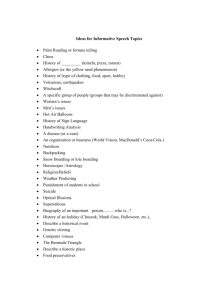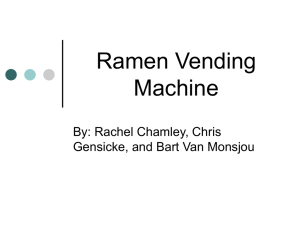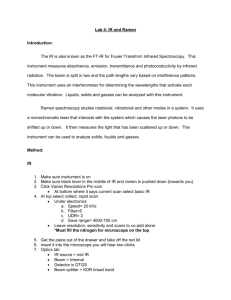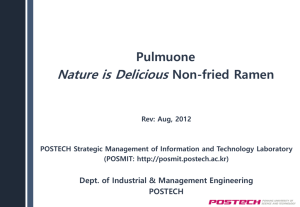Bokuchoi Business Plan Ver.E2
advertisement
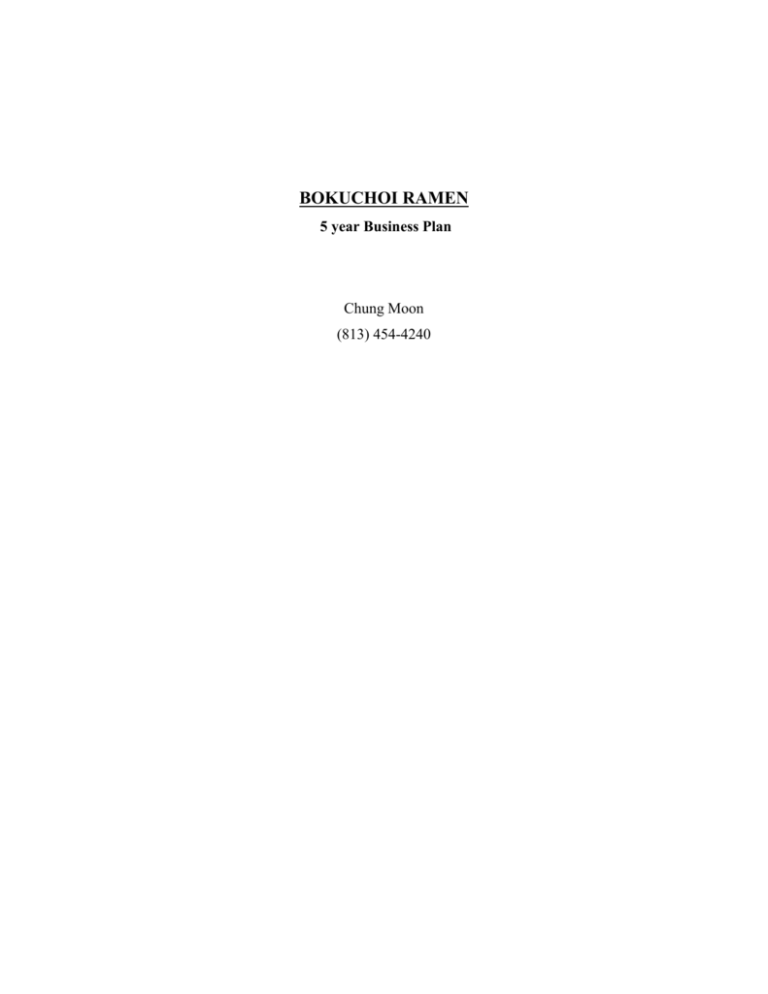
BOKUCHOI RAMEN 5 year Business Plan Chung Moon (813) 454-4240 TABLE OF CONTENTS PLAN SUMMARY ............................................................................................................ 3 COMPANY AND INDUSTRY.......................................................................................... 3 COMPANY ...................................................................................................................... 3 Mission Statement....................................................................................................... 4 Vision Statement ......................................................................................................... 4 INDUSTRY .................................................................................................................... 4 Competition................................................................................................................. 5 Trends ......................................................................................................................... 6 THE PRODUCT ................................................................................................................. 6 Research and Development......................................................................................... 7 Future Developments .................................................................................................. 7 MARKET ANALYSIS ....................................................................................................... 7 Target Market.............................................................................................................. 8 Demographics ............................................................................................................. 9 MARKETING STRATEGY ............................................................................................... 9 Pricing ....................................................................................................................... 10 OPERATIONS .................................................................................................................. 10 Floor Plan .................................................................................................................. 10 Production Process .................................................................................................... 11 Labor ......................................................................................................................... 12 MANAGEMENT AND ORGANIZATION..................................................................... 12 LONG TERM PLANS ...................................................................................................... 13 CRITICAL RISKS ............................................................................................................ 14 FINANCIAL ..................................................................................................................... 14 CONCLUSION ................................................................................................................. 14 REFERENCES ................................................................................................................. 15 PLAN SUMMARY Bokuchoi Ramen belongs to the restaurant industry (NAICS: 722211. SIC: 5812). The restaurant concept is to bring original Japanese ramen noodles to the Tampa Bay area. It will be located at the University Mall in Tampa, FL. Ramen is known by many in the US as the instant noodle that has become a staple in the life of many college students. The ramen that is made from scratch though, can be an incredible experience that everyone should taste at least once in their lives. Although there is a risk in opening up a brand new concept, a 3.6% sales growth in the restaurant industry and the demand of consumers show a promising future for Bokuchoi. In order to provide a good product, the ramen will be prepared all from scratch on location. This is done in order to keep up the standards. This is very crucial since the location has a high density of competitors, and the customers in the area tend to be price conscious as well – the pricing is set slightly higher than the immediate competition. Bokuchoi presents itself with a huge potential to be a success. Over time there is the possibility to expand into different cities such as Minneapolis, MN. COMPANY AND INDUSTRY COMPANY Bokuchoi Ramen is a small ramen noodle restaurant in the tradition of the Japanese staple dish. It is non-seating establishment located at the food court of University Mall in Tampa, FL. Ramen noodle shacks are to Japan what the fast-food restaurants are to the people in the States. They are a place where people go for a quick, rich, filling meal when they don’t have time or simply don’t feel like cooking. The ramen that is being mentioned here is not the one people know as the instant noodles. No, the ramen that is to be sold is the ‘real’ Japanese dish. Similar to the instant version, ramen is simple in concept yet incredibly challenging to produce. When prepared correctly, a bowl of ramen noodles can fix anyone’s day. Bokuchoi Ramen is a dba name for Jackie Moon, LLC. (EIN 27-5272968). The current sole principal of the business is Chung Moon. He is the owner, and general manager of the restaurant. Other employees such as cooks and cashiers will be hired in the near future. Mission Statement To bring the customer the delicious and authentic taste of Japanese ramen with high quality, and at a very affordable price. Vision Statement To become an ambassador of ramen to places in the world that has not yet been graced with the availability of such a delicious dish. INDUSTRY NAICS: 722211 – Limited service restaurants SIC: 5812 – Eating places According to the NAICS classification (2002), Bokuchoi Ramen falls under the category that includes fast-food restaurants. The restaurant industry is forecasted in 2011 to reach a record high of $604 billion, that is 3.6% higher than in 2010. In general, the restaurant industry has been performing better than the average in recent years. $164 billion dollars of those sales belong to the fast service segment of the industry. The restaurant industry is one of the largest employers in the private sector, about 1 in 10 people in the US work in the industry. Florida has one of the higher increases in sales in the industry (restaurant.org) What does this mean? According to forecast, the restaurant industry has remained profitable despite economic downturns in the overall economy. Competition Although there isn’t another ramen shop in a 70 mile radius, it has as many competitors as any other fast-food restaurant, especially those that are closest to the location of the restaurant. Bokuchoi Ramen has a lot of competition around the area. The red dots and lettered pins represent the restaurants in the vicinity of University Mall. This is only in less than half a mile radius. The varieties of these restaurants vary from wings, sandwiches, and burgers, to Vietnamese, Indian, etc. If there is a type of food the customer craves, then this is the place to come to. Around some of the big name restaurants on the area are Fridays, KFC, Chipotle, and Chili’s. Inside the food court a lot there are: -Subway -Ice Cream & Smoothies -Sarku Japan -Cajun Cafe -Perry's BBQ -Charley's -Combo Wok -Chick-fil-a -Sbarro With such a high density of competitors, the business identity could get lost. But it is the unique selling point that is the one key success factor that will not only differentiate the restaurant, but propel it to success. Trends The one major technological trend affecting the industry is social media. A new rising trend is the mobile food service format such as food trucks, carts, etc (restaurant.org) In terms of customer preference, the increased awareness on food has made customer’s pallets more demanding as well as being more open-minded towards new foods. There is also a higher awareness on food quality, and this has in turn made restaurants switch to better foods (restaurant-hospitality.com) THE PRODUCT As previously mentioned, ramen is a very simple dish in concept, but it can be extremely difficult to master. Ramen is by nature a standard food, meant for regular consumption without getting tired of it. Because it is a dish you eat regularly it is meant to be an economical dish (paying $20+ per meal will drain most people’s wallets). The concept of ramen is taking very cheap ingredients and then elevating them to a new level. Therefore, a ramen bowl is projected to be kept at around the price of $8. In order to keep food cost down, and to help with quality control, it is intended three ramen dishes to be served in the menu. Each dish is to be distinctive from the next one, all of them appetizing. The menu is as it follows: Steamed Pork Buns (Steam Buns, Nikuman, Chinese-style buns) - made from scratch, these buns are filled with shredded pork, and some shrimp as well; properly seasoned, and encased in a spongy dough. Pork Ramen (Tonkotsu, Pork Bone) - The broth is made from pork bones that have been boiled for hours to get all the porky goodness out of them. Three porky sides: roasted pork belly, roasted pork loin, and pulled pork. Served with a marinated hard-boiled egg, and bacon strips on top. Chicken Curry Ramen - This is a dish that brings Indo/British and Chinese cuisines together. Rich chicken broth seasoned with East-Asian style curry powder topped with Indian chicken tikka. Served with a tomato-chickpea curry sauce, marinated hard-boiled egg, sugar snap peas, and naan bread. Veggie Ramen (Vegetarian) - Almost a vegan dish if it wasn't for the egg inside the noodles; this dish uses the aromatic components of vegetation to bring a flavor that rivals its meaty counterparts. The broth is made with seaweed and mushrooms. It is served with: tofu, mung beans, cauliflowers, green onions, bok choy, and bean sprouts. Research and Development There was some research that had to take place in order to figure out the dishes because: there are no informational books in English on ramen, and parts of the recipes (i.e. seasoning sauce) are rather secretive. It took months of practice, web surfing, and travelling to major cities in the US with ramen available: LA and NYC. It also helped to have a Japanese friend to help with translation with some of the texts. It took around six months to figure out a dish that takes many years for people to master. There is still a lot more room for improvement. Future Developments Given sales are favorable - also assuming that awareness and demand increase – there are more ramen varieties to be served on the menu. Such dishes include the traditional shoyu ramen and shio ramen along with a more contemporary spicy seafood ramen. Other side dishes are also on review. MARKET ANALYSIS Although ramen is a popular dish overseas, ramen is not a common ethnic staple like sushi. The reason for such a lack of ramen supply is due to two main factors: the lack of know-how of cooking the dish, and the demands of the dish itself. Sushi is a dish that exploded across the world since the late 80s, and it has become a staple in many cities and cultures. There were many places where cooks could go and learn how to make sushi. The instructions for it were all over the place, in English. Ramen on the other hand is a rather secretive dish where Japanese cooks do not like to spread their recipes, so they don’t get translated. It is very difficult to learn how to make ramen if you don’t speak Japanese. There is not a single sushi place that is owned by a Japanese person in Tampa, they are mostly Korean. It takes time to make the noodles, the side dishes, and making the broth alone can easily take an entire day. It takes an eternity to make compared to sushi, or simple fried rice. In the United States, ramen has become a popular dish that has crowded the metro cities of Los Angeles, Boston, Chicago and New York along with other diverse metropolises. In Florida, there are only a few places where one can go and enjoy some authentic ramen; there are none in the Tampa Bay area. The general public who are aware of ramen –mainly college students, know it only by the instant version that come in bags or cups located in the international aisle in the grocery store. Most people do not know how incredible real ramen can be. Bokuchoi’s mission is to bring this dish to the Tampa Bay area. Despite the lack of knowledge, there is one golden rule in which this project relies on; great food will speak for itself. Ensuring quality and flavor standards in each dish served in the restaurant is the only guarantee success over time. The growth opportunity lies with the growing awareness on the dish. In this age people are more eager to try new cuisines. It is only a matter of time until the dish that has become popular in Los Angeles and New York to reach Tampa. I want to be the first one. Target Market Since ramen would be a new concept dish and younger people are more open to different kinds of foods. The target market is people aged 35 and younger with a niche on consumers interested in different cuisines. There is no limit on either: gender, income, culture, or geographical boundaries – limited of course, to those in the Tampa Bay area. Demographics The age demographic in the Tampa Bay is evenly distributed. The larger age range falls within 25-44; which takes up to 30% of the population. The median age is 36, and the average is 38. The population by race is distributed by the following: 66% white, 24% black, 1.5% Asian. 23% of the population is Latino. Household vehicles: 86.6% of households have 1 or more cars. There is a projected increase of 1% per year in population and household owners over the next years (US Census Bureau) The demographic information above shows some favorable trends in population growth. Transportation is crucial for people to reach the restaurant. There are studies of food preference. But even then, there is no way to tell if people in the Tampa Bay would be interested in ramen. They can say that they like Chinese food or sushi, but ramen in itself is a different dish. The only way to find out this specific information would be by running an expensive market research survey. The cheapest alternative to finding any information was by asking people. From all the people around the bay area that were asked, all of them said they would be interested in going to a ramen restaurant. Some had heard of it, but the big problem is that they have never tasted real ramen. And chances are that unless the potential customer has been to Japan or been to a ramen shop in other metropolises, they’ve never tasted ramen. MARKETING STRATEGY Due to low funds allocated in the marketing department, the marketing strategy will be kept at the lowest possible cost. Word of mouth is believed to be the most crucial marketing factor in the restaurant business; it can make or break said restaurant. Bokuchoi will rely mostly on this factor to spread awareness to people. Other than word of mouth, the internet is being used to help propel awareness on Bokuchoi and ramen as a dish. Sites/sources currently in use are: Facebook, YouTube, and Wordpress. The Bokuchoi website will be launched in the near future. There are other marketing sites such as Groupon and Yelp that will be taken into consideration as operations continue. The internet is the most efficient way to reach out to people in a personal level without being intrusive. This allows the consumer to read about Bokuchoi as well as for the customer being able to speak their concern. In this day and age, the internet is accessible enough that people can carry it on their mobile devices. It just doesn’t get better than that. Pricing There is a math formula that restaurants carry with them as a meter to pricing their foods. Cost of food is to be set at around 25% of the price. In addition, rent should take up 15% of forecasted sales. Taking into consideration these factors along with labor costs, volume of sales, and margin preferences should give the management a guide into pricing their menu. There is also another factor to be considered, the immediate competition. Since Bokuchoi is located inside a food court, the pricing of the neighboring restaurants should be accounted in. After taking into consideration all factors involved, the average price per ticket would be at around $9 – $1.5 higher than the average of the competition. Although there is an uncertainty on how elastic the customers will be, the pricing set should reflect the quality of the product as well as stay competitive in terms of price. OPERATIONS Floor Plan NOTE: The hand sinks missing next to the front of house and noodle prep area have already been installed 1 Soda Machine 2 Cash Register 3 Bottled soda cooler 4 Serve area 5 Final assembly area 6 Noodle boiler & noodle container area 7 Electric convection oven 8 Tandoor Oven (gas) 9 Steamer (gas) 10 Pasta machine & Noodle prep area 11 Stand-up mixer 12 8 burner stove + oven (gas) 13 Double stock pot burners (gas) x2 14 Prep tables 15 Freezer 16 3-stage prep sink Production Process The dishes on the menu will all be prepared from scratch due to lack of proper ingredients and to keep the standards in check. All the prep work will be done on the back of the restaurant. Final assembly will be done by order on the front of the house. Cooking that uses any of the gas operated equipment will also be done on the front of the house. The process goes like this: the customer orders at [2] the cash register where the cashier would be standing. The order is then passed to the cook who is standing behind [5] the final assembly area (the cashier would be serving the drinks in the meantime). Assuming that this is a ramen dish, he would put the noodles on [6] the noodle cooker. In the meantime, he would ready up all the sides on [5] the final assembly area. The cook then removes the noodles and gives them a quick dunk on cold water. He would then grab the noodles and put them on a bowl. He would then add the broth, located on one of the burners on [13] the double stock burners. Add the sides on the final prep area, and then serve where the cash register is. This whole process should not take longer than three minutes on a busy day. Labor The general manager is also the head cook in the restaurant. The mall’s operation hours run through 87 hours a week, so there have to be enough workers and shifts to cover said hours while remaining as low cost as possible. There will be two full-time cooks working alternating shifts. They will be working in either the front of the house, or in the back doing some prep work. There is also a part-time position open that would be for the cashier. This position would also have the responsibility to assist the cook and/or the manager with any tasks necessary. MANAGEMENT AND ORGANIZATION This restaurant is a first-time venture for its owner and currently sole manager, Chung Moon. The owner is in charge of all managerial activities from top to bottom. All duties such as payroll, operations, marketing, and financial activities are currently the duties assigned to the owner / general manager. Accounting will be taken care of by an outside firm. LONG TERM PLANS Currently there are no long term plans that are definite. The major objective is to make the location at the University Mall as a running success by having sustainable profits. That is the vision for the first year. Given such success, there will be additional items on the menus implanted along with improvements on the current items. This would take place at around the start of the second year. In three years after the start of Bokuchoi, there are some potential areas for the expansion of the company that could take place. The vision of Bokuchoi is to expand its horizons, not only in the Tampa Bay area, but out of state as well. One such location that shows a great opportunity for growth is Minneapolis, MN. This is an area that would be even more willing to accept ramen as a new staple for the pallets of its denizens than Tampa. Ramen in general is a cold-weather dish. Not only that, but there is a considerable population of Asians in the area, and there is a noticeable interest of the people towards the Japanese culture. This information was gathered through conversation with various people that live in Minneapolis. Expansions through the Tampa Bay area through either stand-alone restaurant set ups or mobile trucks is also a plausible venture in the future. There are no plans in starting franchises as a venture. CRITICAL RISKS Since Bokuchoi is a brand new concept for the Tampa Bay area, it faces one major risk. There is no guarantee that the Bokuchoi concept will work, and there is no data to prove this otherwise. The favorable trend in the restaurant industry sales growth, as well as the increase on the consumer’s interest in new foods helps lessen the severity of this crucial uncertainty. Word of mouth can make or break a restaurant. A review by a food critic can impact a restaurant’s future as well. These two things are a reflection of how the restaurant is managed. Without any previous experience by the owner, this too is a huge risk. FINANCIAL The current income statement and balance sheet are shown on a separate document CONCLUSION Bokuchoi Ramen is a restaurant concept that grabs a staple Japanese dish, and presents it to the Tampa Bay area for the first time. Although there is an uncertainty on how successful it will be; the belief that good food will attract any customer is also the restaurant’s key to success. REFERENCES National Restaurant Association, “Forecast 2011” http://www.restaurant.org/research/forecast/ Restaurant Hospitality, “2011’s Hottest Food Trends” http://restauranthospitality.com/news/hottest-food-trends-1019/ U.S. Census Bureau, “Hillsborough County, FL. Quickfacts” (2011) http://quickfacts.census.gov/qfd/states/12/12057.html
